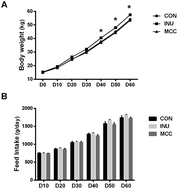Dietary fibers influence the intestinal SCFAs and plasma metabolites profiling in growing pigs†
Abstract
Dietary fibers (DFs), widely used as food additives to replace fat, can benefit metabolic disorders. Soluble and highly fermentable inulin (INU) and insoluble and less fermentable microcrystalline cellulose (MCC) have hypolipidemic or cholesterol-lowering effects, respectively. The current study was aimed at identifying plasma metabolite signatures and metabolic pathways associated with inclusion of DFs with different physiochemical properties, which will lead to a better understanding of functional pathways for DFs to improve metabolic health. Pigs were fed with diets containing 5% INU or MCC or cornstarch (CON) for 60 days. Lipid parameters, fasting hormones and gut SCFAs were measured, and metabolites were profiled with GC-MS. The results showed that the inclusion of 5% MCC decreased the total and LDL-cholesterol in the plasma, while INU only displayed a tendency. Fasting glucagon was decreased by the inclusion of INU and MCC when insulin and leptin remained unchanged. In the cecum and colon, INU increased propionate while MCC increased the colonic branched chain fatty acids. For the first time, specific patterns of metabolite profiles were identified for the INU and MCC inclusion. Four signatures (isoleucine, proline, ornithine and erythrose) were associated with the inclusion of INU, while six metabolites (isoleucine, proline, ornithine, erythrose, hydroxyproline and 5-MIAA) were associated with MCC when compared with the CON group. The direct comparison between the INU and MCC groups revealed significant differences in 5-oxoproline, hydroxyproline, azelaic acid and dodecanoic acid. Identified signatures were enriched in metabolic pathways related to amino acid (arginine and proline; phenylalanine), carbohydrate (pyruvate; galactose) and linoleic acid metabolism. Some amino acid metabolites were also found to correlate with plasma lipid parameters. Our data provided new insights for mechanisms in amino acid and lipid metabolism, by which different DFs could benefit metabolic disorders.


 Please wait while we load your content...
Please wait while we load your content...